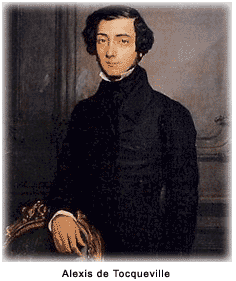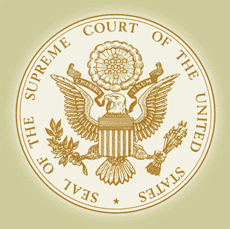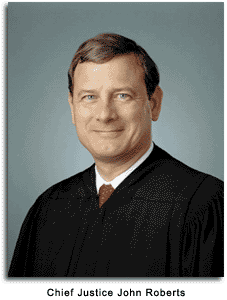In 1835, Alexis de Tocqueville described the Supreme Court of the United States and its role in American society: "The peace, the prosperity, and the very existence of the Union are vested in the hands of the justices of the Supreme Court. Without them, the Constitution (narrative) would be a dead letter: the executive appeals to them for assistance against the encroachments of the legislative power; the legislature demands their protection against the assaults of the executive; they defend the Union from the disobedience of the states, the states from the exaggerated claims of the Union; the public interest against private interests, and the conservative spirit of stability against the fickleness of the democracy."
 The Supreme Court of the United States was authorized by Articles II and III of the U.S. Constitution (text). It was given a general mandate, but details of its organization were left to Congress. The first legislation that came before the U.S. Senate in 1789 was the Judiciary Act, which established a court of one chief justice and five associate justices. The newly established court met for the first time in 1790.
The Supreme Court of the United States was authorized by Articles II and III of the U.S. Constitution (text). It was given a general mandate, but details of its organization were left to Congress. The first legislation that came before the U.S. Senate in 1789 was the Judiciary Act, which established a court of one chief justice and five associate justices. The newly established court met for the first time in 1790.
Under the original legislation, Supreme Court justices were expected to appear in circuit courts in addition to attending to cases that came before the court in Washington, D.C.. However, actually riding through the circuit proved to be an onerous requirement. Congress gradually diminished the requirement as the workload of the Supreme Court itself made its fulfillment more and more difficult. It was not abolished until 1911.
Two characteristics of the court were established in its early years. The first was that the court would not give advisory opinions. Only cases where the court`s findings were binding on the parties, were allowed to reach its docket.
The other characteristic is the court`s supreme position with regard to constitutionality of legislation, a practice known as judicial review. The court`s authority was declared in Marbury v. Madison in 1804. Although it was challenged by the Jeffersonians, the Supreme Court was able to maintain its position, and its paramount role in this area is no longer disputed.

The Supreme Court has a traditional seal similar to the Great Seal of the United States. It also boasts a single star beneath the Eagle`s claws, which symbolizes the Constitution`s creation of "one Supreme Court." The seal is kept by the Clerk of the Court. Its image is stamped on such official papers as certificates given to attorneys newly admitted to practice before the Court. The current seal is the fifth in the Court`s history.
The current rules, under which the court operates, were adopted in 1925. In the 1930s, President Franklin D. Roosevelt proposed what became known as the "court packing scheme." In reaction to a number of rulings by the court against FDR`s New Deal legislation, he proposed expanding the number of judges from nine to 15. The new judges would presumably be favorable to the New Deal. Public opposition to the plan came from both parties. Many felt that the court`s independence should not be sacrificed. The issue became moot when the court changed its attitude towards Roosevelt`s legislation.
Under Chief Justice Earl Warren, appointed by President Dwight D. Eisenhower in 1953, the Court entered an "activist" phase. Its first important decision was Brown v. Board of Education in 1954, overturning the 1896 Plessy v. Ferguson decision that had permitted "separate but equal" treatment of blacks. Other milestone rulings included Miranda v. Arizona, which obliged law enforcement officers to advise an accused of his right to an attorney, and Gideon v. Wainwright, which commanded courts to ensure that anyone accused of any felony be provided with an attorney. Other rulings allowed universities to adopt Affirmative Action policies that favored minority applicants. Those decisions also encouraged the private sector to hire women or minority employees over their male counterparts when their qualifications were equal.
The most controversial "activist" decision was Roe v. Wade, which took place during the administration of Chief Justice Warren Burger. Burger, appointed by President Richard Nixon, concurred in the majority decision that a woman`s right to an abortion in the first trimester was guaranteed due to her right to privacy, a right not explicitly mentioned in the Constitution.

Primarily as a reaction to Roe, the appointment of federal judges, particularly Supreme Court judges, has become increasingly politicized. Sandra Day O`Connor, the first woman and 102nd person chosen for the highest court, will be remembered for being the swing vote in close decisions.
In 1967, Thurgood Marshall became the first African American to be an associate justice on the Court. He was nominated by President Lyndon Johnson, who declared that it was “the right thing to do, the right time to do it, the right man and the right place."
Clarence Thomas, the second African-American justice on the court, took his seat in October 1991 after long and arduous confirmation hearings in the Senate. William Rehnquist provided the court with its most conservative chief justice in half a century. With John Roberts entering as chief justice in 2005, the court`s directions seem likely to remain conservative for many years.